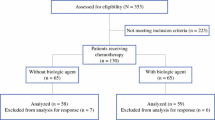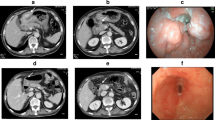Abstract
The effect of anti-epidermal growth factor receptor (EGFR) antibody-containing chemotherapy on appendiceal signet-ring cell carcinoma (SRCC) remains unknown. Herein, we report three patients, diagnosed as having synchronous metastases, who underwent this treatment for unresectable appendiceal SRCC with RAS wild type. Cases 1, 2, and 3 received FOLFOX with panitumumab, FOLFOX with cetuximab, and FOLFIRI with cetuximab, respectively, and their progression-free survival were 6.2, 7.2, and 18.7 months, respectively. The subsequent anti-vascular endothelial growth factor antibody-containing therapy was ineffective, and their overall survival was 8.2, 11.4, and 22.9 months, respectively. The anti-EGFR antibody-containing chemotherapy showed moderate efficacy for appendiceal SRCC. Further studies including molecular analysis should be needed.



Similar content being viewed by others
References
McCusker ME, Coté TR, Clegg LX et al (2002) Primary malignant neoplasms of the appendix: a population-based study from the surveillance, epidemiology and end-results program, 1973–1998. Cancer 94:3307–3312
Connor SJ, Hanna GB, Frizelle FA (1998) Appendiceal tumors: retrospective clinicopathologic analysis of appendiceal tumors from 7,970 appendectomies. Dis Colon Rectum 41:75–80
Kaji S, Harada N, Suzuki S et al (2009) A clinicopathological study of four cases of primary appendiceal cancer (in Japanese). J Jpn Coll Surg 34:17–21
Ozawa H, Kotake K, Matsui K et al (2012) Statistics of appendiceal malignant tumors: data from the JSCCR Registry and the Japan Autopsy Annual Database (in Japanese). Daichougan Front 5:150–153
Henry M, Delavari N, Webber J (2020) Undiagnosed case of signet ring cell colorectal carcinoma: a case report and review of the literature. Clin Colorectal Cancer 19:e83–e86
Nitecki SS, Wolff BG, Schlinkert R et al (1994) The natural history of surgically treated primary adenocarcinoma of the appendix. Ann Surg 219:51–57
Tung SY, Wu CS, Chen PC (1996) Primary signet ring cell carcinoma of colorectum: an age- and sex-matched controlled study. Am J Gastroenterol 91:2195–2199
Sim HL, Tan KY, Poon PL et al (2008) Primary rectal signet ring cell carcinoma with peritoneal dissemination and gastric secondaries. World J Gastroenterol 14:2118–2120
McGory ML, Maggard MA, Kang H et al (2005) Malignancies of the appendix: beyond case series reports. Dis Colon Rectum 48:2264–2271
Turaga KK, Pappas SG, Gamblin T (2012) Importance of histologic subtype in the staging of appendiceal tumors. Ann Surg Oncol 19:1379–1385
Lieu CH, Lambert LA, Wolff RA et al (2012) Systemic chemotherapy and surgical cytoreduction for poorly differentiated and signet ring cell adenocarcinomas of the appendix. Ann Oncol 23:652–658
Saltz LB, Clarke S, Díaz-Rubio E et al (2008) Bevacizumab in combination with oxaliplatin-based chemotherapy as first-line therapy in metastatic colorectal cancer: a randomized phase III study. J Clin Oncol 26:2013–2019
Van Cutsem E, Köhne CH, Hitre E et al (2009) Cetuximab and chemotherapy as initial treatment for metastatic colorectal cancer. N Engl J Med 360:1408–1417
Douillard JY, Siena S, Cassidy J et al (2010) Randomized, phase III trial of panitumumab with infusional fluorouracil, leucovorin, and oxaliplatin (FOLFOX4) versus FOLFOX4 alone as first-line treatment in patients with previously untreated metastatic colorectal cancer: the PRIME study. J Clin Oncol 28:4697–4705
Douillard JY, Oliner KS, Siena S et al (2013) Panitumumab-FOLFOX4 treatment and RAS mutations in colorectal cancer. N Engl J Med 369:1023–1034
Dahabreh IJ, Terasawa T, Castaldi PJ et al (2011) Systematic review: anti-epidermal growth factor receptor treatment effect modification by KRAS mutations in advanced colorectal cancer. Ann Intern Med 154:37–49
Ang CS, Shen JP, Hardy-Abeloos CJ et al (2018) Genomic landscape of appendiceal neoplasms. JCO Precis Oncol 2:1–18
Raghav KP, Shetty AV, Kazmi SM et al (2013) Impact of molecular alterations and targeted therapy in appendiceal adenocarcinomas. Oncologist 18:1270–1277
Choe JH, Overman MJ, Fournier KF et al (2015) Improved survival with anti-VEGF therapy in the treatment of unresectable appendiceal epithelial neoplasms. Ann Surg Oncol 22:2578–2584
Yoshizawa J, Shirozaki T, Inoue K et al (2013) A case of advanced signet ring cell carcinoma of the appendix that responded to S-1 and docetaxel (in Japanese). Nihon Shokakibyo Gakkai Zasshi 110:1934–1942
Powell ED, Macdonald DB, Elkeilani AM et al (2009) A case of appendiceal adenocarcinoma with clinical benefit from FOLFOX and bevacizumab. Case Rep Oncol 2:111–115
Ko YH, Jung CK, Oh SN et al (2008) Primary signet ring cell carcinoma of the appendix: a rare case report and our 18-year experience. World J Gastroenterol 14:5763–5768
Kulkarni RV, Ingle SB, Siddiqui S (2015) Primary signet ring cell carcinoma of the appendix: a rare case report. World J Clin Cases 3:538–541
Harada S, Tsuchida K, Shibuya T et al (2015) Experience of the pharmacotherapy against appendix and sigmoid colon signet ring cell carcinoma with the peritoneal dissemination (in Japanese). Gan To Kagaku Ryoho 42:1268–1270
Kusakari C, Soda H, Nakamura Y et al (2007) Mediastinal signet-ring cell carcinoma of unknown primary: long-term survival by treatment with S-1, a novel derivative of 5-fluorouracil. Lung Cancer 56:139–141
Tejpar S, Stintzing S, Ciardiello F et al (2017) Prognostic and predictive relevance of primary tumor location in patients with RAS wild-type metastatic colorectal cancer: retrospective analyses of the CRYSTAL and FIRE-3 trials. JAMA Oncol 3:194–201
Shen H, Yang J, Huang Q et al (2015) Different treatment strategies and molecular features between right-sided and left-sided colon cancers. World J Gastroenterol 21:6470–6478
Tournigand C, André T, Achille E et al (2004) FOLFIRI followed by FOLFOX6 or the reverse sequence in advanced colorectal cancer: a randomized GERCOR study. J Clin Oncol 22:229–237
Borazanci E, Millis SZ, Kimbrough J et al (2017) Potential actionable targets in appendiceal cancer detected by immunohistochemistry, fluorescent in situ hybridization, and mutational analysis. J Gastrointest Oncol 8:164–172
Shirota Y, Stoehlmacher J, Brabender J et al (2001) ERCC1 and thymidylate synthase mRNA levels predict survival for colorectal cancer patients receiving combination oxaliplatin and fluorouracil chemotherapy. J Clin Oncol 19:4298–4304
Kim SH, Kwon HC, Oh SY et al (2009) Prognostic value of ERCC1, thymidylate synthase, and glutathione S-transferase pi for 5-FU/oxaliplatin chemotherapy in advanced colorectal cancer. Am J Clin Oncol 32:38–43
Shaojun C, Li H, Haixin H et al (2018) Expression of topoisomerase 1 and carboxylesterase 2 correlates with irinotecan treatment response in metastatic colorectal cancer. Cancer Biol Ther 19:153–159
Van Cutsem E, Tabernero J, Lakomy R et al (2012) Addition of aflibercept to fluorouracil, leucovorin, and irinotecan improves survival in a phase III randomized trial in patients with metastatic colorectal cancer previously treated with an oxaliplatin-based regimen. J Clin Oncol 30:3499–3506
Cremolini C, Antoniotti C, Stein A et al (2020) Individual patient data meta-analysis of FOLFOXIRI plus bevacizumab versus doublets plus bevacizumab as initial therapy of unresectable metastatic colorectal cancer. J Clin Oncol 38(28):3314–3324. https://doi.org/10.1200/JCO.20.01225
Glockzin G, Zeman F, Croner RS et al (2018) Perioperative systemic chemotherapy, cytoreductive surgery, and hyperthermic intraperitoneal chemotherapy in patients with colorectal peritoneal metastasis: results of the prospective multicenter phase 2 COMBATAC trial. Clin Colorectal Cancer 17:285–296
Acknowledgements
We would like to thank Editage (http://www.editage.com) for English editing.
Author information
Authors and Affiliations
Corresponding author
Ethics declarations
Conflict of interest
The authors declare that they have no conflict of interest.
Research involving human participants and/or animals
All procedures performed in studies involving human participants were in accordance with the ethical standards of the institutional and/or national research committee and with the 1964 Helsinki Declaration and its later amendments or comparable ethical standards.
Informed consent
Informed consent was obtained from all individual participants included in the study.
Additional information
Publisher's Note
Springer Nature remains neutral with regard to jurisdictional claims in published maps and institutional affiliations.
About this article
Cite this article
Hirose, S., Enami, C., Kawamatsu, N. et al. Systemic chemotherapy combined with anti-epidermal growth factor receptor antibody therapy for RAS wild-type appendiceal signet-ring cell carcinoma: a series of three cases. Int Canc Conf J 11, 17–22 (2022). https://doi.org/10.1007/s13691-021-00507-w
Received:
Accepted:
Published:
Issue Date:
DOI: https://doi.org/10.1007/s13691-021-00507-w




